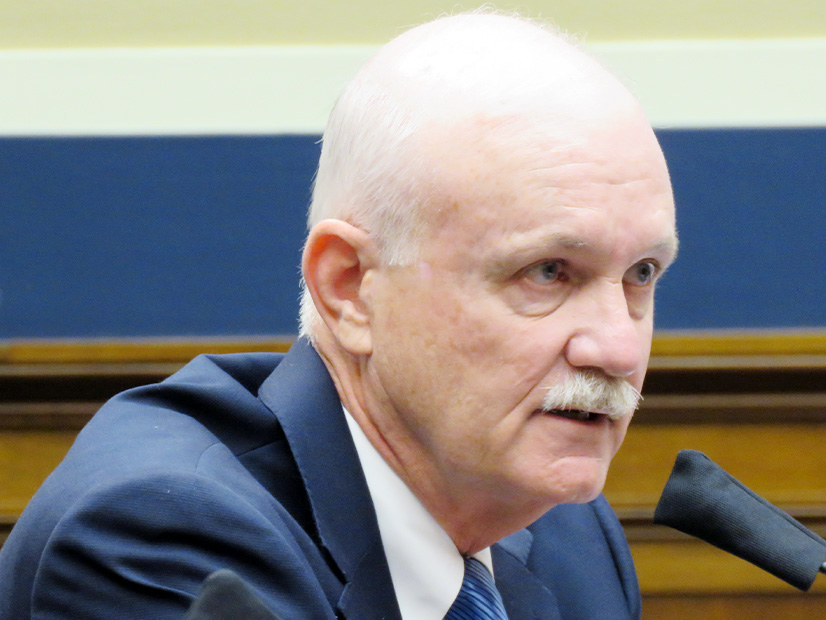RTOs and ISOs should reconsider the practice of relying on single clearing price mechanisms in organized electricity markets, FERC Commissioner Mark Christie argued in an Energy Law Journal article published Monday.
Use of a single clearing price (SCP) means that every resource dispatched is paid as much as the last unit needed to meet demand, which has the highest price among them.
“As a result, sellers that have offered to sell at prices lower than the clearing price, including those offering at zero or even below zero due to out-of-market subsidies, still receive the highest clearing price,” Christie wrote. “As consumers’ power bills continue to rise, however, both the EU and UK are reconsidering whether the continued use of SCP mechanisms is in the best interests of hard-pressed consumers and whether changes to pricing structures need to be made to give consumers the full potential cost savings available from low to zero marginal cost resources.”
The European Union is looking into the issue because the single clearing price means that many of the savings associated with renewables that deliver at very low to below-zero marginal cost do not flow through to consumers. That makes it a timely discussion to have in the U.S., Christie said.
RTO capacity markets also clear at a single price, and Christie said they have bigger problems that are in need of more immediate reforms.
“These constructs are critically important not only because of their impact on the costs consumers pay for power resources, but on the reliability of the power grid itself,” the article said. “Indeed, it is past time to reconsider whether such constructs, certainly those in the large, multistate RTOs, are still capable of performing the important duties expected of them.”
In creating capacity markets, RTOs conceded that investors need certainty on future revenues and that energy market revenues were not sufficient to encourage investment in capital intensive generation.
“The creation of these markets also destroys any argument that deregulation was all about shifting investment risk for generation assets from consumers to investors,” Christie said. “It never was, certainly not where capacity markets were established to provide the ‘missing money’ to investors.”
The capacity markets differ by region, but they all pay a single clearing price, which is at best zonal and thus far less granular than the locational marginal prices used in energy markets. And the forward nature of the markets involves assuming what load will be in the future, and some guesswork around supply as well.
“Those operating the capacity markets are speculating on future supply and demand just as integrated resource planners in vertically integrated utilities are speculating,” the article said. “Both are engaging in an administrative planning exercise.”
Capacity markets are facing more immediate problems, but Christie does not want to limit the reconsideration to them.
“While acknowledging that there are serious arguments in favor of continued use of the LMP mechanism in certain markets, the article asserts that such arguments should not prevent an open-minded consideration of equally serious arguments made against continued use of single clearing price mechanisms in U.S. power markets, including the practical question whether LMP itself, which may be effective in some scenarios, can continue to deliver what it promises under today’s conditions,” the article said.
Beyond ‘Textbook’ Theory
Reassessing single clearing price mechanisms will require reconsideration of the assumptions that drove restructuring of the industry in the 1990s and early 2000s and whether they still apply to present conditions.
Restructuring was driven by a sense among policy makers that generation was no longer a natural monopoly, largely because of the development of efficient and low-cost natural gas-fired resources. FERC and some states both pushed the change, and while transmission remained a monopoly, its control was handed over to ISO/RTOs that took over the planning role from utilities.
The transfer of control of transmission development made it harder for states to regulate what was happening in that area, which was common beforehand with integrated resource plans (IRPs).
“Overseeing the IRP process had long been one of the states’ most effective tools for ensuring just and reasonable retail rates and reliable service, the two chief goals of state utility regulation,” the article said. “The IRP process enabled state regulators to balance the need for one type of proposed resource, be it generation, transmission, distributed energy or demand-side, against other alternatives, potentially of lower cost.”
The main defense of single clearing price is that the field of economics treats electricity as a commodity, and all commodities are priced that way, but “textbook” theory is not enough to justify its continued use alone, Christie said.
“Even the most ardent advocates of RTO markets admit that certain public policies, especially subsidies, that have been widely adopted since the advent of those markets, are antithetical to their efficient operation,” the article said. “So any serious reconsideration of single clearing price mechanisms cannot be confined to textbook economic theory, but must take into account how public policies have distorted the pricing mechanisms in RTO power markets that use marginal costs to determine outcomes and how these policies are likely to continue to do so.”
Any re-examination of such a fundamental construct of organized electricity markets requires a full comparison to alternatives, Christie said.
“That is because choosing public policies always involves tradeoffs, and any criticism of one policy must consider criticisms of alternative policies,” he added. “So any serious reconsideration of single clearing price mechanisms in U.S. power markets must evaluate just as critically the alternatives and their advantages and disadvantages.”


